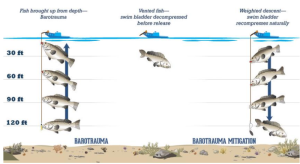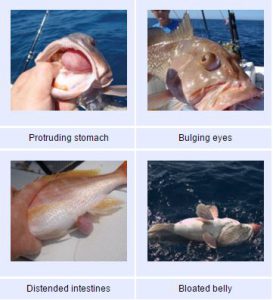It’s no secret that Florida is one of the top fishing destinations in the world. Fortunately, our fisheries are very well-managed with regulations set by the South Atlantic Fishery Management Council (SAFMC) in federal waters, and Florida Fish and Wildlife Conservation Commission (FWC) in state waters. These agencies use best available sciences to set these rules so that all Floridians, residents and visitors alike can enjoy fishing now and in the future.
Some of those regulations include bag limits (how many of certain species can be caught per person, per day) and size limits (the minimum size a fish must be to be kept). When fish are caught that do not meet these criteria, they should be released back into the water to continue growing, reproducing, and perhaps be caught on another day.
However, sometimes when practicing catch-and-release fishing, the released fish do not return underwater or survive. This is largely due to a pressure injury called barotrauma (baro=pressure, trauma=injury). This is most commonly seen when fishing in water deeper than thirty feet, when the fish is brought to the surface and cannot release the gas in its swim bladder, the organ used to regulate the fish’ position in the water column. The released fish is then too buoyant to return to the bottom on its own.

Barotrauma commonly manifests with very obvious signs: the stomach protruding from the mouth, bulging eyes, the swim bladder pushing the intestines through the anus, and bubbling scales. The severity of the pressure injury increases in severity and likelihood according to the depth where it is caught. A fish that has suffered barotrauma is highly unlikely to be able to swim back to the bottom, and will almost certainly die at the surface, effectively negating the point of its release. Barotrauma is very common in popular snapper and grouper species, which are some of the most targeted for recreational fishing.

While this condition can be serious, there is good news: there are two approaches that can be taken to address barotrauma prior to release: venting and assisted descent. Venting refers to the physical piercing of the fish’s swim bladder with a special hollow needle, allowing the trapped air to escape and the fish the capability of returning to the bottom. You can view how to vent in this cool video.
If needles make you nervous, there is another technique that is just as effective. Descending devices are now required on board and easily accessible in all federal waters per the SAFMC. There are three types of descending devices: a weighted milk crate (a “fish elevator”), a mouth grip and inverted hook. Using any of these three techniques are good alternatives to venting and easy to set up and use. For more information, check out this publication about barotrauma which goes into more detail. I have also seen barotrauma in ornamental reef fish species, like the queen angelfish featured in the banner photo of this post. My dive buddy and I were not fishing and did not have any of the listed tools on board. Instead, we swam the fish 25 feet to the bottom to recompress its swim bladder.
You can also learn more about mitigating barotrauma by taking the free Florida Friendly Angler course online. By returning ‘em right, we all actively participate in making our fisheries sustainable for everyone and for the future.
 0
0
